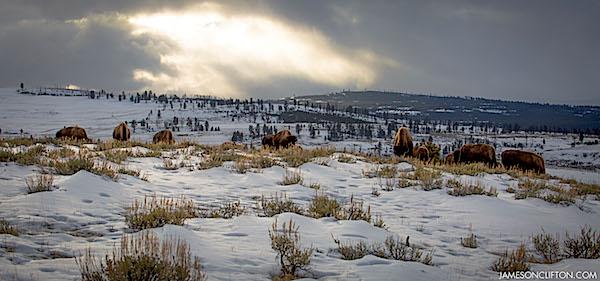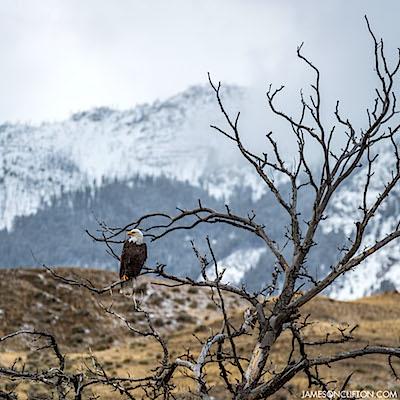
Winter drives wildlife to lower elevations in Yellowstone, making animals easier to spot/Jameson Clifton
I finished my college finals a week earlier than most of my peers, and since it hadn't snowed enough in the local Wasatch Mountains, heading up to the slopes was out of the question. After three days of sitting at home watching Netflix re-runs, I got a serious case of cabin fever. I was past due for an outdoor excursion: the farther the better. Why not Yellowstone?
As an Australian exchange student at the University of Utah, my goal is to explore as many iconic national park destinations as I can within a two-day drive from Salt Lake City. There are almost 3,500 square miles to explore in our first national park, so I packed my bags, gassed up the truck, and hit the road, traveling through the stunning Wyoming, Idaho, and Montana countryside along the way.
Yellowstone in the winter is very different than the popular tourist seasons of summer and early fall. Beginning in early November, only the park's North and Northeast entrances are open by car, which leaves much of the interior inaccessible except by snow travel. The few that make this trip are rewarded with a sense of serenity and solitude.
When the snow sets in, many of the park's animals begin to move to the lower elevations of the valleys, a perfect time for 'incomparable wildlife viewing,' according to the National Park Service. And sure enough, I saw plenty of bison, mule, and whitetail deer, the occasional elk, moose, and even a very distant wolf pack running across the Lamar Valley one afternoon.
There are a lot of snow-specific activities in this winter landscape. Back in Gardiner, Montana, the gateway town at the North Entrance, I grabbed a park trail map and chatted to the employees at the Yellowstone Association, looking for activities and destinations. Cross-country skiing through the Towers Area between Mammoth and Cooke sounded like an excellent idea. Luckily, I'd brought a pair of skis and was itching to try them out on some of the fresh snow.
I explored most of the trails within the Tower area, and fell in love with cross-country skiing in the process. The workout alone was addicting, but so was gliding through one of North America's best wilderness destinations by myself.
The easiest, and best-groomed, trail was the Tower Falls Trail. It's 2.5 miles one way and parallels the road and Yellowstone River canyon from Roosevelt Lodge to the Tower Falls store. It was a great introduction to the sport. There are lots of bison and coyote along the trail, and the canyon scenery provides a fantastic backdrop. On reaching the Tower store I took a hike down to the base of the falls for a truly spectacular close-up view of a frozen waterfall as well.

Bald eagles can be spotted fairly easily in winter in Yellowstone/Jameson Clifton
The Lost Lake Trail starts at the Petrified Tree turnoff. It's a bit more difficult at 5 miles one way, but winds its way through the majestic Yellowstone backcountry, serving up views of mountain ranges, forests, Lost Lake, streams, and another frozen waterfall. This is a must-ski trail for any cross-country enthusiast.
The 7-mile Blacktail Plateau Trail is the longest, and most strenuous, in the Towers area, and my favorite of the trip. I gradually ascended 900 feet in 6 miles through rolling meadows and hills and, again, encountered numerous bison and elk on the trail. Normal wildlife precautions should be taken. At one point during my journey I encountered three bison in the middle of the track, who had absolutely no intention of moving. My only option was to hike around.
Once back on track, the freshly groomed sections where fairly easy, and a welcome surprise on the way to the highest point, The Cut at (7,571 feet). From there the descent began slowly before a 2-mile moderate downhill that led back to the parking area. As a solo traveler I didn't have a shuttle car available, and after an 8-mile trek, I'd had plenty of cross-country for one day. Luckily, there's a steady stream of traffic that travels the road from Cooke City in the late afternoon, and I was able to hitch a ride back to the trailhead with a friendly local on his way to Mammoth. The beautiful sunset that evening back at camp finished the day perfectly.
Simply stated, Yellowstone in winter is a wilderness wonderland.
Jameson Clifton is an editorial intern for the Traveler.



Comments
Are fatbikes allowed on XC ski trails?
To my knowledge XC trails within the park are restricted to skiing and snowshoeing.
It'll probably take the NPS another 10 to 20 years to catch up with the times.